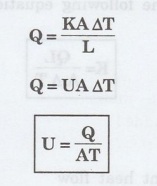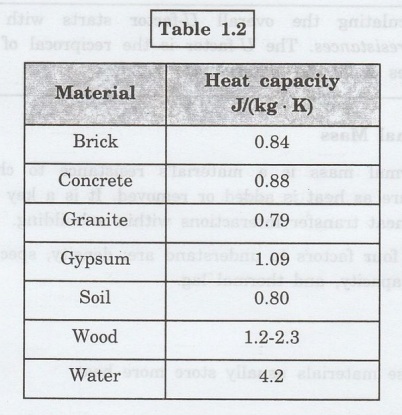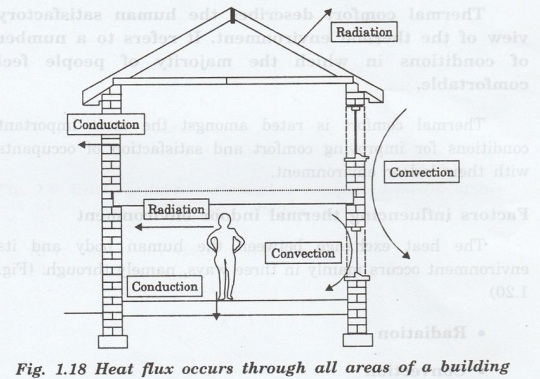Physics For Civil Engineering: Unit I: Thermal Application
Thermal Measurement
Every material used in an envelope assembly has fundamental physical properties. These properties determine their energy performance like conductivity and resistance
THERMAL MEASUREMENTS
Every material used in an envelope
assembly has fundamental physical properties. These properties determine their
energy performance like conductivity and resistance. Understanding these
properties helps us to choose the right materials for heat flows.
1. Thermal Conductivity (K)
It is a material's ability to conduct heat.
Each material has a characteristic rate
at which heat will flow through it. The faster heat flows through a material,
the more conductive it is.
It is a material property given for
homogeneous solids under steady state conditions.
It is given by the following equation:
K= QL/A∆T
where
Q- the resultant heat flow
K- thermal conductivity of the material
(W/mK) or Wm -1 K-1
A - surface area through which the heat flows (m2)
∆T
- temperature difference between the warm and cold sides of the material
(K)
L - thickness of the material (m)
2. Thermal Conductance (C)
It
is the thermal conductivity per unit area for a specified thickness. It is used
for standard building materials.
In basic building materials, heat flow
is usually measured by thermal conductance (C), not thermal conductivity.
Thermal conductance is a material's thermal conductivity per unit area. It has
unit of W m-2 K -1
3. U - Factor (U)
It is the overall conductance of a
building element. It is used for layered building assemblies.
In layered assemblies, thermal
conductances are combined into a single number called the "U-factor" (or sometimes the "U-value").

U is the overall coefficient of thermal
transmittance. It is expressed in terms of W/(m2 K). The thermal
conductance is used for specific material, whereas U -factor is used for a
specific assembly. Lower U-factors mean less conduction, which means better
insulation.
For instance, the overall U-factor of a
window includes the thermal conductances of the glass panes, air inside,
framing material, etc.
4. Thermal Resistance (R value = 1/U)
It is a material's ability to resist
heat flow.
It is designated as R (R value), thermal resistance indicates how effective any
material is as an insulator.
The reciprocal of thermal conductance is
known as thermal bewar resistance R. It is measured in SI unit of m2 K/W.
• For
a homogeneous material such as wood, doubling the thickness will double the R
value. These values are not specified for assemblies of materials. U - factors
are used for assemblies.
Thermal insulation which prevents heat
flow through the building envelope, is often measured by its R-value. A higher
R - value indicates a better thermal insulating performance.
Calculating the overall U-factor starts
with adding thermal resistances. The U-factor is the reciprocal of sum of
resistances of all the material, U= 1/Σ R.
5. Thermal Mass
Thermal mass is a material's resistance
to change in temperature as heat is added or removed. It is a key factor in
dynamic heat transfer interactions within a building.
The four factors to understand are:
density, specific heat, thermal capacity, and thermal lag.
Density
Dense materials usually store more heat.
Density is the mass of a material per
unit volume. In the SI system, it is given as kg/m3. For a fixed
volume of material, greater density will permit the storage of more heat.
Specific
Heat
High
specific heat requires a lot of energy to change the temperature.
Stud Specific heat is a measure of the
amount of heat required to raise the temperature of given mass of material by
1°K. In the SI system, it is expressed as J/kg K.
It takes less energy input to raise the
temperature of a low-specific-heat material than that of a high-specific-heat
material.
For instance, one gram of water requires
one calorie of heat energy to rise 1°C. Water has a high heat capacity and
therefore is sometimes used as thermal mass in buildings.

Thermal
Capacity (Thermal Mass)
Density × Specific Heat
= How much heat can be stored per unit volume
Thermal
capacity is an indicator of the ability of a material to
store heat per unit volume.
The greater the thermal capacity of a
material, the more heat it can store in a given volume per degree of
temperature increase.
Thermal capacity for a material is
obtained by taking the product of density and specific heat. Unit is J/K.
Higher thermal capacity can (but will
not always) reduce heat flow from the outside to the inside environment by
storing the heat within the material.
6. Insulation and Window Performance
Some of the highest thermal energy
losses from a building are through windows and poorly insulated walls. (Fig.
1.18)
There is currently no accurate way of
monitoring how well a building's thermal insulative materials are performing.
Highly expensive infrared cameras are
typically used to compare the efficiencies of different windows and insulation
but reflectivity of the surfaces dramatically affects their accuracy.
IR cameras are also limited because they
only show relative maps of temperature and not quantitative heat loss. These IR
instruments often give false information about the thermal envelope of
buildings and how well the insulation is performing.

Unlike typical thermal sensors that only
give values of temperature at certain locations, heat flux sensors directly
IsmedT measure thermal energy through surfaces.
Heat flux sensors can be used to
determine R-values of windows, walls, and other building materials. (Fig. 1.19)
Measured heat flux values from heat flux
sensors can be correlated to total heat loss from a building.

Physics For Civil Engineering: Unit I: Thermal Application : Tag: : - Thermal Measurement
Related Topics
Related Subjects
Physics for Civil Engineering
PH3201 2021 Regulation | 2nd Semester Civil Dept 2021 Regulation
